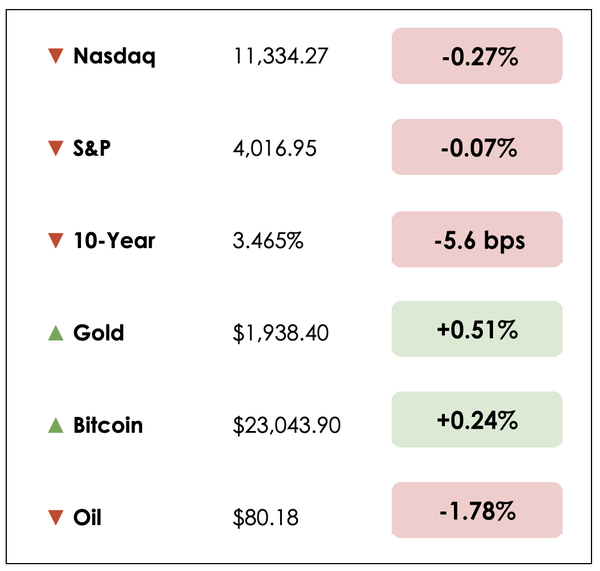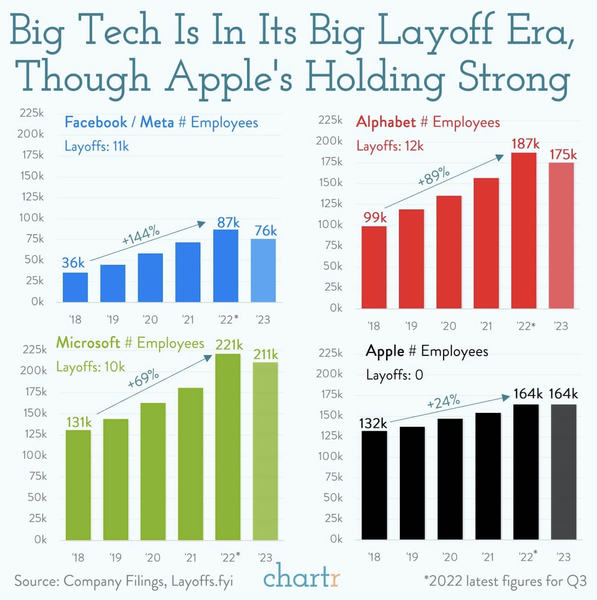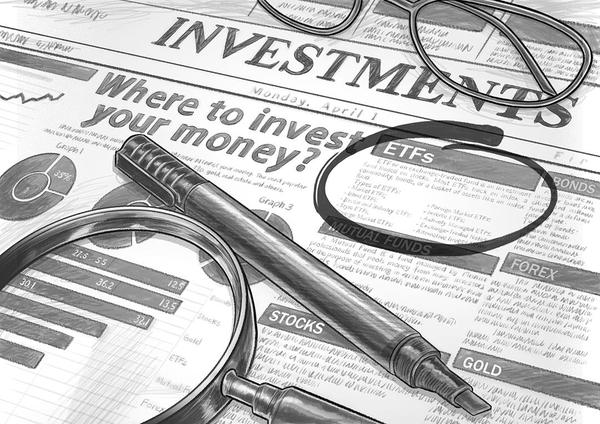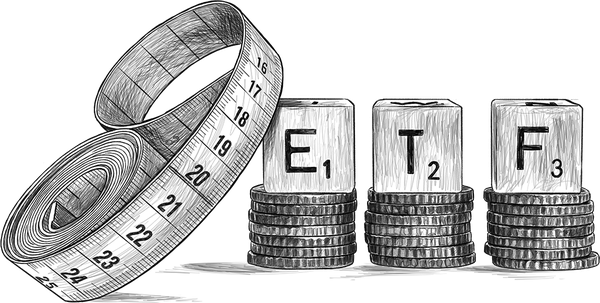Launching Your Own ETF
24 January 2023

Hi, The Investor’s Podcast Network Community!
💪 The economy continues to defy recession predictions, with the Philadelphia Fed’s latest survey of non-manufacturing businesses revealing that 38% of respondents saw increases in activity as opposed to the 25% that saw declines.
And despite declining overall, S&P Flash PMI data reached three-month highs in business output and activity.
We got more earnings today, as 3M (MMM), the maker of Post-Its and Scotch Tape, reported weakening sales and layoffs of 2,500 manufacturing workers that sent the stock down over 6%.
Johnson & Johnson (JNJ) reported a 25% decline in earnings as demand for its Covid-19 vaccine dropped off, and General Electric (GE) stock jumped on strong demand for its jet engines and power equipment.
Microsoft (MSFT), the first of the tech giants to report, rose 5% in after-hours trading after beating earnings estimates and showing strong growth in its cloud division ☁️
Here’s the market rundown:
MARKETS
*All prices as of market close at 4pm EST
Today, we’ll discuss two items in the news: how Apple has avoided layoffs thus far, and why the wealthy are ditching their savings accounts, plus our main story on how to launch your own ETF.
All this, and more, in just 5 minutes to read.
Get smarter about valuing businesses in just a few minutes each week.
Get the weekly email that makes understanding intrinsic value
easy and enjoyable, for free.
History of positive returns ✔️
Inflation-hedging potential ✔️
Resistance to market volatility ✔️
Land has helped investors preserve wealth for generations, and AcreTrader makes it easy to diversify with farm and timberland assets online — Find out how.
IN THE NEWS
- While layoffs have hit the tech industry, Apple (AAPL) has avoided them thanks largely to lean hiring. The iPhone maker’s workforce grew 20% in the past three years, a far slower pace than rivals.
- Microsoft (MSFT), Alphabet (GOOGL), Meta (META), and Amazon (AMZN) have all cut jobs in recent months amid a challenging economic environment. Apple has slowed hiring in some areas but hasn’t announced layoffs.
- Apple added employees at a much slower clip than other large tech companies during the pandemic, and it tends to run lean, with relatively limited employee perks. The company has about 65,000 retail employees working in more than 500 stores worldwide, making up about 40% of its workforce.
- Apple has been a steady growth machine for decades, with its last big round of layoffs (4,100 employees) way back in 1997, when co-founder Steve Jobs returned to the company.
- Apple’s core business has been resilient against broader downturns: In its September quarter, Apple reported that sales at its most important business, the iPhone, advanced 9.7% from the previous year to $42.6 billion, beating analyst estimates.
- Apple might reduce headcount through attrition by not replacing workers who leave. Revenue from its services business has slowed, growing 5% annually to $19.2 billion in the September quarter, shy of the gains posted in recent quarters. Apple, nearly 7% of the S&P 500, reports earnings on Feb. 2.
- Wealthy savers are taking cash out of bank accounts because big banks are still paying paltry interest rates on checking and savings accounts, even as the Fed raises rates at the steepest pace in decades.
- They’re moving the extra savings into products whose rates have more closely tracked the Fed, such as Treasury notes, money-market funds, and brokered certificates of deposits paying between 4% and 5%, rather than 0.33%, which the typical savings account now pays.
- Affluent customers are moving money into money-market funds and Treasuries, Bank of America CEO Brian Moynihan said recently, while typical consumer banking clients simply had less money to do so.
- “Every time the Fed hikes, the opportunity cost of leaving idle cash in low-yielding accounts increases,” said Jason Goldberg, an analyst at Barclays PLC. “You’re seeing consumers who have extra cash being proactive with it.”
- Gary Zimmerman, CEO of MaxMyInterest, a service that helps clients of financial advisers move their extra cash into high-yielding savings accounts at smaller banks, said it’s been a “frenzy” of moving money into high-yield accounts. “Clients are coming to us and linking a million-dollar checking account at Wells Fargo.”
- While the Fed raised rates sharply in 2022, big banks didn’t. One reason savings account rates have remained so low is that financial institutions profit when the rate on the money they lend out is higher than the rate they pay people who deposit money into savings. For many banks, the pandemic actually created a glut of deposits as well.
Do you have an idea for your own exchange-traded fund (ETF)?
Launching your own is now easier than ever before. A group of “white label” ETF issuers are helping people launch ETFs, and business is booming.
More than 100 ETFs have been created this way, serving both large asset managers and entrepreneurial individuals.
What to know
According to senior ETF analyst at Bloomberg, Eric Balchunas, these firms manage all of the logistics and infrastructure of an ETF, including legal and administrative costs, and connect you with market makers to ensure smooth trading.
Your main job, apparently, is just to market the fund and design the strategy while they manage everything else. Of course, having your own publicly-traded ETF isn’t cheap, but it’s possible if you have ample funds.
These white-label issuers aren’t small, trivial firms, either. Goldman Sachs recently entered the business, validating this growing phenomenon.
Breaking it down
According to Goldman Sachs, white-label providers “help to lower barriers to entry, opening up the opportunity for fund managers of any size to have their own ETFs.”
That’s because they provide a “full-service offering” that includes “product development, compliance, capital markets, sales, and distribution.”
According to Lisa Mantil, Head of Goldman Sachs ETF Accelerator, “Many of our clients have told us they believe the next wave of growth is in active ETFs. They want to be a part of that growth but don’t have the expertise or infrastructure to do so. We are delivering a digital solution that allows us to partner with our clients on that journey.”
The ETF market is dominated by Vanguard, StateStreet, and BlackRock’s iShares, though their largest funds tend to be generic passive strategies that track, say, the S&P 500. Per Bloomberg’s Eric Balchunas, much of the strategy innovation in ETFs comes from smaller, independent issuers not associated with these industry titans.
And white-label providers are proving key in facilitating this.
A changing paradigm
See, when new entrants design attractive and unique investment strategies that may appeal to other investors, they must consider whether they’re willing to incur the considerable financial and time costs associated with an ETF.
This ranges from regulatory approval to fund accounting to ongoing portfolio management. The whole process would typically take around two years and $2-3 million in upfront costs, in addition to hiring a team of people to oversee operations.
For years, this suppressed the emergence of riskier and more niche investing approaches.
White-label ETF issuers, however, essentially offer tremendous economies of scale in the asset management business to those who want to launch a fund.
Per Sam Masucci of ETF Managers Group, a white-label provider, someone could launch an ETF through their firm in less than three months with initial costs of roughly $75,000.
For ongoing expenses, approximately $250,000 per year would cover everything else.
He explains that his company offers “a very cost-efficient way to bring ideas to market” as they “have great third-party relationships with custodians (banks) and with auditors. All that saves time and money.”
The business model
Should you want to design a portfolio and strategy to underpin an ETF and then pony up the money to get it launched, the hope is that you’d recoup your costs and even make a profit by charging small management fees as a fixed percentage of assets under management (typically between 0.3-1%).
As you attract more investors to your fund, the fund’s assets grow and deliver greater fees to you.
That puts pressure on you and anyone launching an ETF to design a novel investing strategy and market it well.
This, in part, includes selecting a catchy ticker for trading. The Global X Robotics and Automation ETF, ticker ROBO, is a great example of a fund that outlined a compelling strategy, investing in companies that are driving transformative innovations in robotics and automation, with an appropriate ticker.
Since its inception in 2013, its net assets have ballooned to over $1 billion while collecting a 0.95% management fee yearly. ROBO was brought to market via the white-label ETF issuer Exchange Traded Concepts.
Takeaways
Starting your own ETF is still an expensive and likely unprofitable business, given the vast number of existing competitors, especially as barriers to entry fall.
Although we wouldn’t encourage you to launch an ETF, as an investor and consumer of these financial products, you’re likely to be the ultimate winner.
By making it easier for new ETFs to launch within a white-label provider’s framework, competition will continue to pour into the space, driving down fees while providing you with increasingly specialized investment options.
It’s a trend worth watching in the coming years, especially as mutual funds and hedge funds increasingly look to convert to a more liquid ETF structure using white-label issuers.
Dive deeper
To learn more, listen to this Bloomberg podcast.
If you want to experience long-form conversations with some of the most interesting and experienced investors, economists, traders, and thought leaders in the world — hosted by a group of highly experienced practitioners, who have all managed large portfolios during their career — then you need to follow the Top Traders Unplugged Podcast and sign up to the TTU Weekly Newsletter.
Sign up TODAY for investment news, insights, & resources that move investors to reclaim control of their portfolios!
It may be the best investment of your time!
That’s it for today on We Study Markets!
See you later!
If you enjoyed the newsletter, keep an eye on your inbox for them on weekdays around 6pm EST, and if you have any feedback or topics you’d like us to discuss, simply respond to this email.















